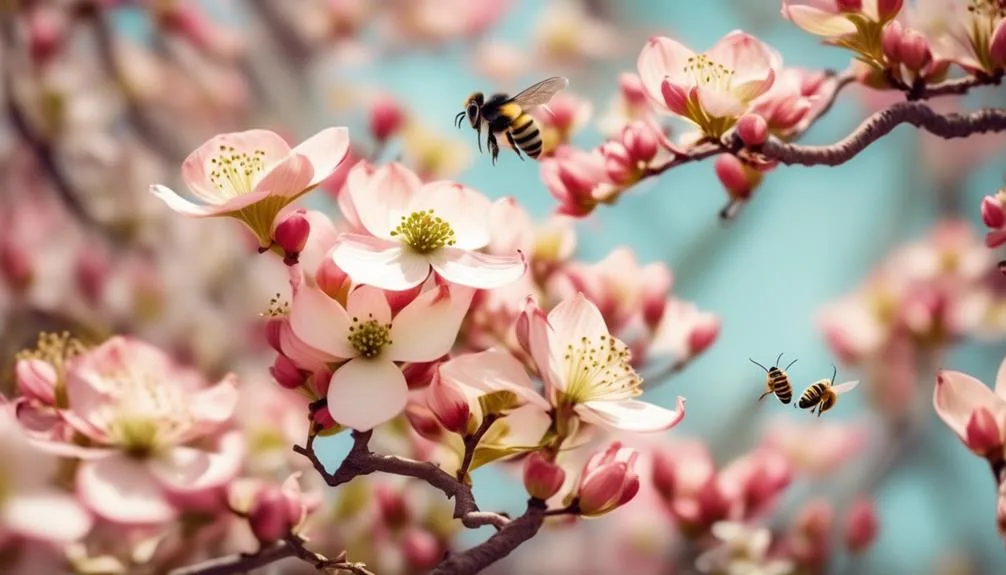Dogwood trees play a crucial role in supporting local pollinators. Their elegant, flowering presence in gardens attracts buzzing and fluttering friends, offering more than just visual appeal.
The connection between these trees and pollinators is fascinating, with potential benefits worth exploring. If you're curious about the impact of dogwood trees on the buzzing activity in your garden, stay tuned to uncover their significance for the local pollinator population.
Types of Dogwood Trees for Pollinators
When choosing dogwood trees to attract and support pollinators in your garden, consider native species such as the flowering dogwood (Cornus florida) and the Pacific dogwood (Cornus nuttallii) for their vibrant blooms and nectar-rich flowers.
These native species are excellent choices for tree selection as they've co-evolved with local pollinators, providing essential food sources and habitat.
The flowering dogwood, with its iconic four-petaled white or pink blooms, attracts bees, butterflies, and hummingbirds with its abundant nectar.
Similarly, the Pacific dogwood, adorned with clusters of creamy white flowers, serves as a vital nectar source for pollinators.
Attracting Pollinators With Dogwood Trees
Considering the vibrant blooms and nectar-rich flowers of native dogwood species, you can easily attract and support pollinators in your garden. Dogwood trees are a fantastic addition to any pollinator-friendly landscaping. Their blossoms provide an abundant source of nectar for bees, butterflies, and other beneficial insects.
The attractive flowers of dogwood trees act as a magnet for pollinators, enhancing the biodiversity of your garden. Additionally, the presence of pollinators can lead to improved fruit set in nearby plants, making your garden more productive.
Dogwood Trees' Impact on Pollinator Populations
To understand the impact of dogwood trees on pollinator populations, observe the bustling activity as bees and butterflies are drawn to the vibrant blossoms, enhancing the biodiversity of your garden. Dogwood trees play a crucial role in ecosystem services by providing a haven for pollinators, supporting the intricate web of life in your backyard.
Here's how dogwood trees impact pollinator populations:
- Attracting a diverse array of bees, including honeybees, bumblebees, and solitary bees, which diligently gather nectar and pollen from the dogwood blossoms.
- Serving as a vital food source for butterflies, such as swallowtails and monarchs, as they flit from flower to flower, aiding in the pollination process.
- Contributing to the overall health of your local ecosystem by bolstering the population of pollinators, thereby promoting plant reproduction and enhancing the biodiversity of your surroundings.
Best Practices for Planting Dogwood Trees for Pollinators
As you aim to create an inviting haven for pollinators in your garden, maximizing the impact of dogwood trees involves implementing best practices for their strategic planting and maintenance. To ensure that your dogwood trees are pollinator-friendly, proper soil preparation is essential. Choose a location with well-draining, slightly acidic soil, and consider incorporating organic matter to enhance soil structure and fertility. When it comes to proper spacing and tree selection, make sure to plant dogwood trees at a distance that allows for ample airflow and sunlight penetration. This not only promotes healthy growth but also creates an appealing environment for pollinators. Selecting native dogwood tree species can further support local pollinator populations. Consider the table below for a quick reference to best practices for planting dogwood trees for pollinators:
| Best Practices | Description |
|---|---|
| Soil Preparation | Choose well-draining, slightly acidic soil |
| Pollinator Friendly | Incorporate organic matter for soil fertility |
| Proper Spacing | Plant at a distance to allow airflow and sunlight |
| Tree Selection | Consider native species for supporting pollinators |
Maintaining Dogwood Trees to Support Pollinators
Supporting pollinators through proper maintenance, such as regular pruning and monitoring for pests, is crucial for the health and longevity of your dogwood trees. Here are some essential tips to maintain your dogwood trees and support pollinators:
- Pruning Techniques: Trim dead or diseased branches to promote healthy growth and encourage more blooms, providing ample nectar and pollen for pollinators.
- Watering Schedule: Ensure your dogwood trees receive adequate water, especially during dry periods, to maintain healthy foliage and vibrant blossoms that attract pollinators.
- Pest Monitoring: Regularly inspect your dogwood trees for signs of pests or disease, taking appropriate measures to mitigate any issues and safeguard the tree's ability to support pollinators.
Conclusion
Incorporating dogwood trees into your garden can significantly benefit local pollinators. Their vibrant blooms and nectar-rich flowers provide essential nourishment for bees, butterflies, and other pollinators.
By nurturing these trees, you not only enhance the local pollinator population but also add a touch of natural beauty to your outdoor space.
How will you welcome these valuable contributors to your garden?

My interest in trees started when I first saw the giant sequoias in Yosemite.
I was a teenager then, and I remember thinking, “I need to learn more about this.”
That moment stuck with me.
A few years later, I went on to study forestry at Michigan Tech.
Since graduating, I’ve worked in a mix of hands-on tree care and community education.
I’ve spent over ten years helping people understand how to plant, maintain, and protect the trees in their neighborhoods.
I don’t see trees as just part of the landscape.
They are living things that make a real difference in our daily lives.
